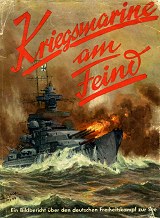Coastal Command Operations in connection with the Bismarck and Prinz Eugen, 21st-27th May, 1941
(Published in Supplement to The London Gazette, Tuesday, 14 October 1947)
May 21st.At 1300 hours an aircraft of P.R.U. located and photographed one Bismarck class battleship and one Hipper class cruiser at anchor in small fiords near Bergen.
The weather deteriorated during the afternoon and evening but a strike of 6 Whitleys of No. 612 Squadron and 12 Hudsons of Nos. 220 and 269 Squadrons took off between 2150 and 2330 hours to attack. Owing to bad weather conditions only 2 Hudsons dropped bombs, and poor visibility prevented any results being observed.
May 22nd.
Aircraft patrolled off the Norwegian coast from first light but weather conditions by 1000 hours had forced all of them to return. Blenheims of No. 248 Squadron maintained meteorological sorties off the coast all day reporting the weather conditions, which became, worse with 10/10 cloud down to sea level.
Sunderlands of No. 201 Squadron maintained a patrol up the meridian of 5º West between latitudes 6220 N and 6500 N from 0930, but had to return at 1100 on account of fog with nil visibility.
At 1930 a Fleet Air Arm Maryland succeeded in penetrating to the anchorages and found the billets empty and no sign of the vessels in Bergen roadstead.
May 23rd.
The Norwegian coast patrols could not take off owing to weather conditions. Sunderlands of No. 201 Squadron carried out a patrol between the Faeroes and Iceland from 0650-2000 and Hudsons of No. 220 Squadron patrolled between the Shetlands and Faeroes from 0400-1250, when they had to be recalled as the base was closing down. Catalinas of No. 210 Squadron, after a delayed start due to weather, patrolled to the south of Iceland from 1300-1650 when they also had to be recalled as the bases in United Kingdom were closing down. Iceland based aircraft should have patrolled the Denmark Strait but here again weather conditions of continuous rain, cloud 10/10 at 300 feet and visibility of 1,000 yards forced the abandonment of all flying. These conditions improved slightly towards the end of the day and, after the sighting of the enemy force by H.M. Ships SUFFOLK and NORFOLK at 1922 and 2028 respectively, it was found possible to get aircraft off at 2225 and 2320 to locate and shadow the enemy.
May 24th.
The Sunderland of No. 201 Squadron which had taken off from Reykjavik sent a first sighting report of the enemy at 0620 and followed this up with four subsequent amplifying signals, the last being at 0900. The action between the BISMARCK and H.M. Ships PRINCE OF WALES and HOOD was witnessed and bearing and distance of enemy signals given to H.M.S. NORFOLK. The Sunderland also signalled the position of survivors of H.M.S. HOOD at 1000 and the fact that BISMARCK was leaving a large trail of oil fuel.
The Hudson of No. 269 Squadron which had taken off at 2320 on the 23rd May did not locate the enemy, but another Hudson of the same Squadron did so and reported at 0554. This aircraft also witnessed the action in which H.M.S. HOOD was sunk, and continued shadowing until 0808. A third Hudson located and shadowed the enemy from 0905 till 1340.
A Catalina of No. 240 Squadron from Reykjavik contacted the enemy at 1432, shadowing until 1640. During this time frequent bearings and distances of the enemy were given to the two cruisers and the PRINCE OF WALES. Fire was opened on this aircraft by both enemy ships from time to time. Finally, a Catalina of No. 210 Squadron took off at 1612, but did not sight the enemy in worsening weather visibility although all three H.M. Ships were sighted at 2127 and a formation of F.A.A. aircraft at 0035 on the 25th. During the day 6 aircraft of No. 22 Squadron armed with torpedoes flew from Wick to Kaldadarnes in Iceland as a strike force, together with Catalina and Sunderland reinforcements.
May 25th.
At 0306 hours contact with the enemy force was lost by the two shadowing cruisers and in order to assist re-location a long range sweep by Catalinas was organised. This sweep was designed to cover either a break back to Norway or a course shaped by the enemy for French Biscay ports. The Catalinas took off at 1345 and did not land back until 1030 on 26th May. Some of our own surface forces were sighted but no positive enemy sighting was made, although one Catalina at 0120 on 26th May passed over the wake of a heavy ship which gave no answer to challenge or signals. The aircraft circled for an hour but in the darkness and low cloud at 500 feet it was impossible to establish any identity. The position, course and estimated speed of this unknown ship was signalled to base but fuel supply would not permit shadowing until dawn. As it was, this aircraft did not land back until 1203 on 26th May.
May 26th.
As additional precautions to prevent a break back to Norway, Hudsons of No. 269 Squadron patrolled the Denmark Strait throughout the day in very bad weather conditions, a further sweep was carried out south of Iceland by two Sunderlands, one Catalina and one Hudson, and a continuous patrol was maintained between the Faeroes and Iceland by two Sunderlands.
To endeavour to prevent an unseen escape into a French Biscay port two patrols were placed athwart the estimated line of advance from the last sighted position of the enemy towards the Bay of Biscay. On the initiative of the A.O.C.-in-C., Coastal Command, the southern of these two patrols was somewhat to the south of the general appreciation as to the likely course steered by these two ships. A Catalina of No. 240 Squadron flew the northern patrol and a Catalina of No. 209 Squadron the southern patrol. Both were on patrol by 0930 hours.
At 1030 hours aircraft "Z" of No. 209 Squadron sighted the BISMARCK and sent a first-sighting report. An amplifying report was sent five minutes later while the aircraft was taking cover in cloud. At 1039 cloud cover was inadvertently broken almost over the BISMARCK, which immediately opened fire, and before cloud could be regained the aircraft was hit by shrapnel and holed in several places. The other Catalina was diverted to assist in the shadowing and made a sighting report at 1328. Meanwhile "Z" of No. 209 Squadron had lost touch in worsening visibility at 1045. Efforts to re-locate failed, though at 1510 this aircraft sighted and communicated with the other Catalina—"M" of No. 240 Squadron— which by this time had also lost touch. "Z" then left the scene for base, plugging the holes in the hull, and landed safely at Loch Erne. Meanwhile "M" regained contact with an enemy ship at 1600 and continued to report positions and courses until 1800, when contact was lost and the aircraft had to return to base having reached prudent limit of endurance.
A relief Catalina—"O" of No. 210 Squadron— had been flown off at 1215 to continue the shadowing. At 2340 this aircraft sighted and reported an enemy ship and continued to signal positions at intervals until 0240 hours on 27th May.
May 27th.
At 0404 this aircraft reported having lost touch with the enemy ship, though at 0712 it signalled the presence of a Blohm and Voss float plane, after which limit of endurance forced a return to base after a flight of 26 hours 12 minutes.
As the Hipper class cruiser —PRINZ EUGEN— last seen in company with the BISMARCK early on 25th May was unaccounted for, Coastal Command maintained two patrols by Sunderlands of No. 10 Squadron across the mouth of the Bay of Biscay from dawn during the day, and Hudsons of No. 206 Squadron carried out searches in this area from 0900 till 1830, while Wellingtons of No. 221 Squadron completed the patrols across the mouth of the Bay up till 1900 hours.
Over the whole period from the locating of the two enemy ships near Bergen on 21st May until dusk on 27th May, aircraft of Coastal Command flew 69 sorties, totalling 580 hours flying, while searching for or shadowing these two ships.

Copyright © 1998-2024 KBismarck.com


